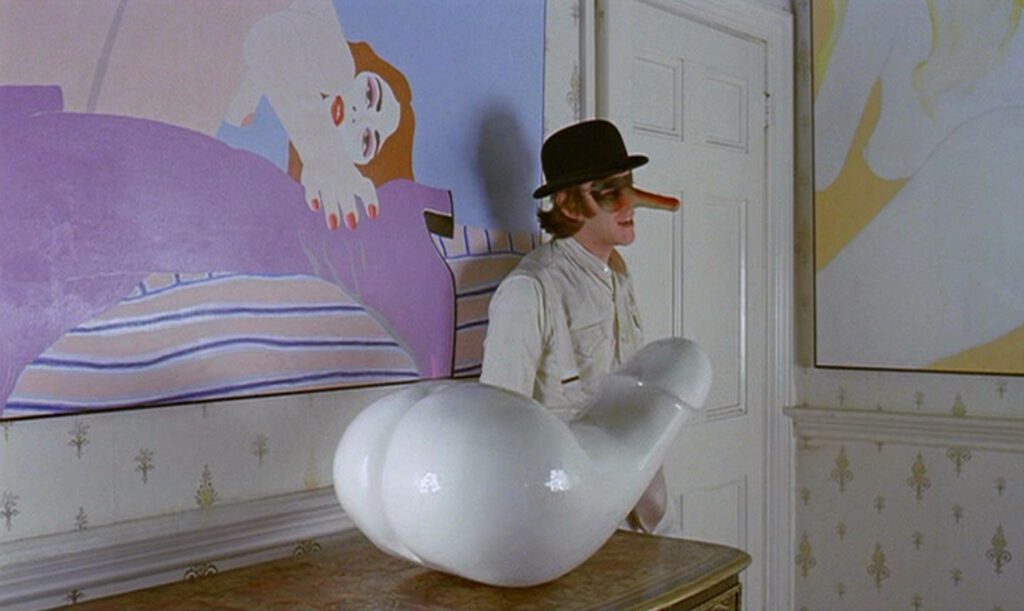
A Clockwork Orange
1971, directed by Stanley Kubrick
Amid all of its grotesquery and violence, we should not lose sight of the fact that A Clockwork Orange builds to a partnership. When the press crowds into the hospital to photograph Alex grinning beside the Interior Minister, it’s not just a bit of offhand irony to wrap the story up on a clever note; rather it’s very much the point of the story. Up until this ending we’ve been immersed in a world of cruelty, and it had looked as though the chief conflict were between legal and illegal cruelty; but the movie wants us to understand that in the long run, whatever form it takes, cruelty tends to ally with other cruelty.
One of the biggest clues to this intent is the fate of Alex’s mates (or “droogs” in their Russian jargon) Georgie and Dim. It may be surprising when they turn up suddenly as cops to arrest Alex and beat him, but nobody who understands how our world works should be too surprised that these hoodlums have joined the police force. Many delinquents waste their lives in prison or unemployment, but society also has ways of co-opting violent youths to serve its own violent ends. Alex’s path is not so different; he too is co-opted by tyrannical forces to serve their own designs. At their first meeting the Minister of the Interior is delighted with Alex’s qualities, but most especially with his viciousness. He clearly finds Alex useful. Moments earlier the Minister had let it slip that his motive for relieving crowding was to make room for political prisoners. Under a right-wing regime violent criminals are potential assets, certainly a lesser concern than political enemies. As long as a fascist can project an image of law and order, the actual rule of law is not needed.
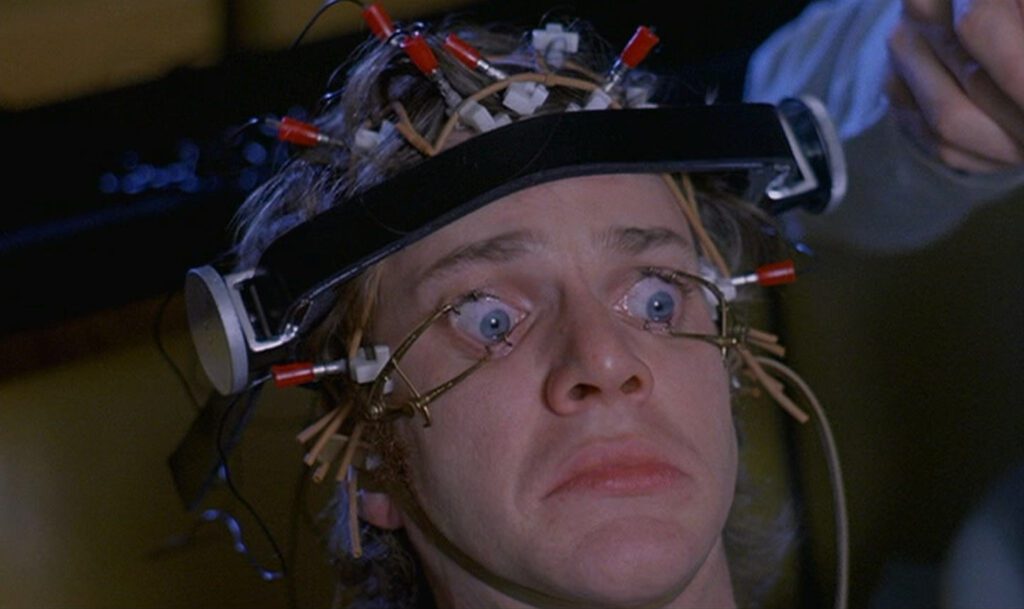
Alex’s journey from outlaw to integral member of society might look far-fetched, like some dystopian fiction removed from our present reality, but in fact the stages of his transformation mirror the ways society has accultured youths for over a century. Alex’s life of crime through the first third of the film is a metaphor for early childhood. Like a small boy he’s self-centered, testing his limits, unfettered by any sense of right or wrong. His imprisonment is the first stage of acculturation, like a child forced by social institutions (family, school, church) to conform to expected rules of behavior. In the second stage, the Ludovico Technique corresponds to the Pavlovian incentives that compel an adolescent to internalize the same rules imposed earlier from above.
The last stage of Alex’s acculturation is the invisible one. The Ludovico treatment finally wears off, as evidenced by Alex recapturing his enjoyment of Beethoven’s Ninth in the hospital. In his psychological exam, filling in the missing cartoon captions, it was already plain that Alex was his old self again. The psychiatrist had smiled through the exam, apparently pleased with Alex’s answers. By the standards of a vicious society Alex has finally grown up, and as long as he can channel his antisocial instincts in ways that serve the ruling system, it’s considered acceptable and even desirable.
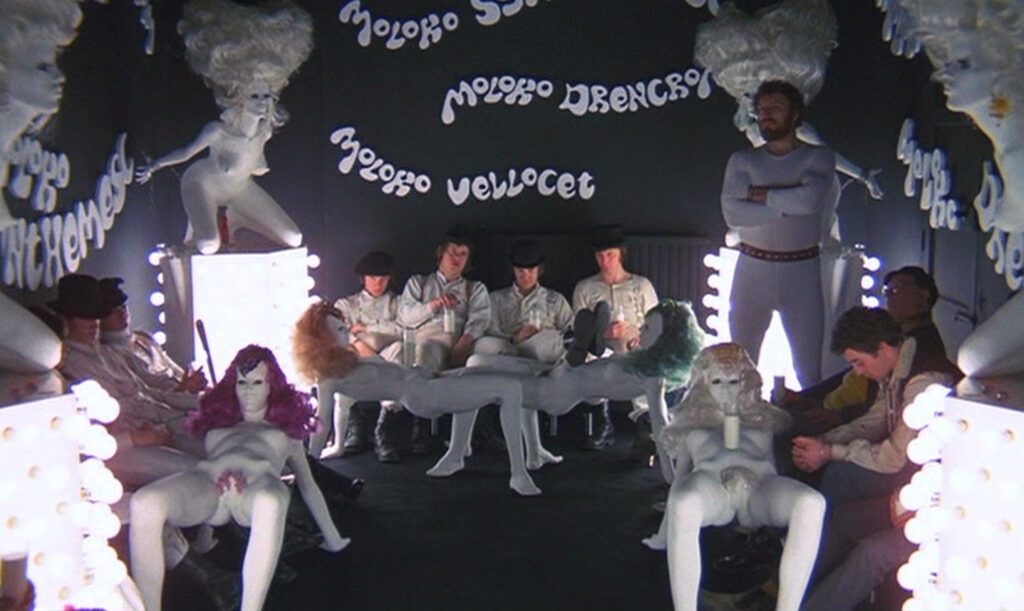
Of course Alex has not truly grown up. A Clockwork Orange portrays a society that conspires to retard its members’ emotional growth, keeping them in a state of juvenile savagery. From this point of view we can start to understand the dual role of violence and sex throughout the movie. All the cruelty that we see is a channeling of sexual drives. Violence and cruelty always seek orgasmic release – witness Mr. Alexander’s face as he punishes Alex, blaring Beethoven up through the floor to drive the boy to attempt suicide. When Alex and his droogs confront Billyboy’s gang on the verge of raping a naked woman, the gang immediately forgets their victim and enters the fight with relish, as if violence were a greater pleasure than sex. The violence here – as it is in real life – is filled with phallic objects: billy clubs and knives, codpieces, the long nose on Alex’s mask, and the literal sculpture of a penis Alex uses to kill the Catlady at the “health farm”.
The youth culture depicted in A Clockwork Orange is thoroughly oedipal. Alex and his friends hang out at a milk bar, hinting at the strange bond that still ties them to their mothers. Alex’s parents are the cartoonish portraits you’d expect from an oedipal boy-narrator’s point of view – a weak father and a provocatively dressed mother, both viewed with the contempt of a boy who hates his father and is disappointed in his mother. Alex’s hatred of old men finds an outlet in the violence against the homeless drunkard and against Mr. Alexander, and when the crowd of elderly hobos attacks him under the bridge it’s a grotesque picture of intergenerational warfare.
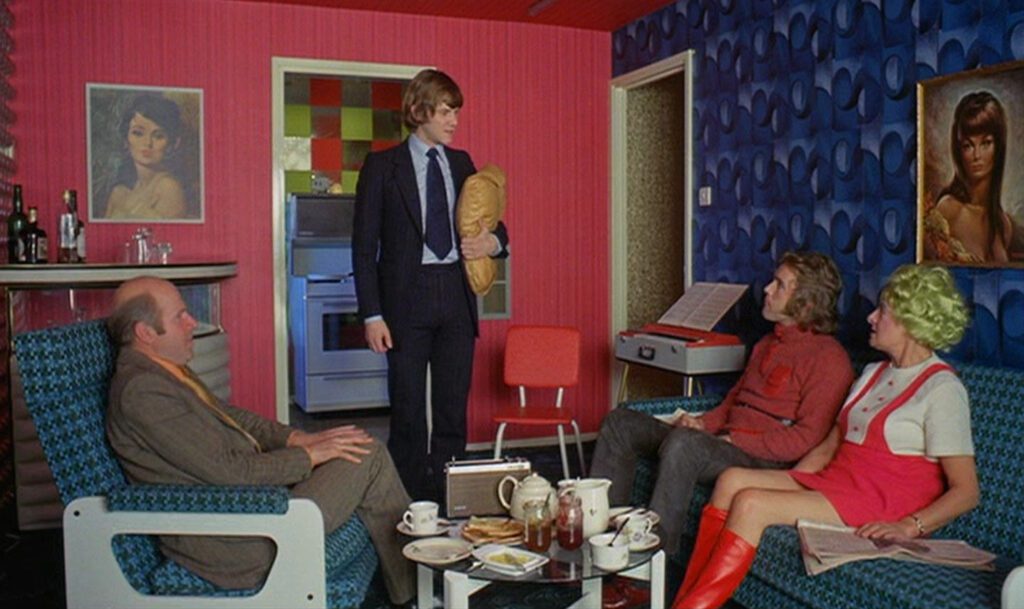
As valid as the movie’s analysis may be, it’s still fair to criticize it for reveling too much in its violent sexuality. Stanley Kubrick voluntarily withdrew the film from circulation in the United Kingdom after a copycat rape and two murders. Whether the film actually inspired any crimes may be hard to prove, but some of its most infamous scenes, especially the home invasion, celebrate cruelty with an excess of dramatics. The greatest error is surely that Alex is made larger than life – he’s too clever and too cool, like so many gangsters glorified in Hollywood films. These flaws may diminish the film, but they shouldn’t detract from the importance of its argument.
A Clockwork Orange warns us what society could become – and what many societies have become at various times in history – if political power is aligned with the cruel impulses of juvenile sexuality. It’s beyond the movie’s scope to show us the way out of its nightmare, but as long as viewers and critics understand the film, its definition of the real-world threat should go a long way toward preventing such a dystopia from forming. The movie does, however, incorporate examples of resistance to cruelty, and in each case it’s instructive to look at why the resistance fails.
The first case of resistance is the old drunkard who talks back to Alex from the far end of a billy club, berating the boys as a symptom of a “stinking world”. Alex asks him what’s so wrong with the world, and the tramp replies that “there’s no law and order anymore.” As we’ll see later with the Minister of the Interior, the old man’s assessment of society makes him a prime target for politicians who will proclaim “law and order” while undermining genuine peace and security.
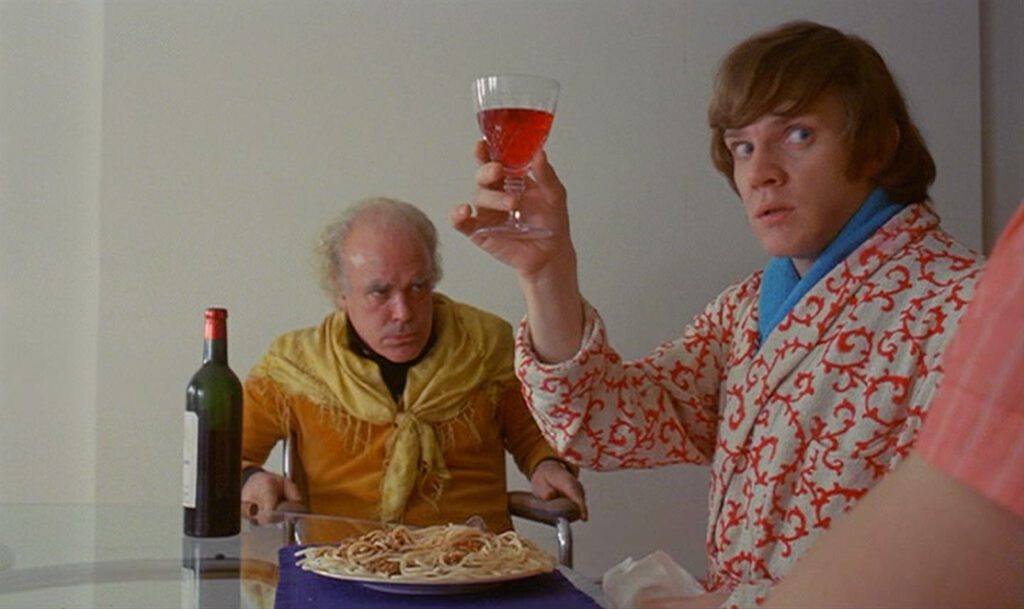
Mr. Alexander, whose home Alex invades and whose wife he rapes, appears to be another point of resistance. On the phone to his co-conspirators planning to use Alex against the incumbent government, he speaks of “liberty” and “totalitarianism”. Later the Minister of the Interior calls him a “subversive writer”. He’s clearly a liberal opponent of the ruling party. The movie is far from sympathetic toward him, but it would be too simplistic to say that it’s attacking both sides of the political spectrum. The problem with Mr. Alexander is not that he’s liberal but that he, like too many liberals, is just as easily co-opted by the right as Alex is. On the phone he says that the “common people” must be “led, driven, pushed.” His fear of totalitarianism ironically draws him closer to his opponents’ methods, as his wish for revenge impels him to turn fascist against Alex.
The prison chaplain is a third example of resistance. He objects to the Ludovico treatment, arguing that it only changes people superficially. “Goodness comes from within,” he tells Alex, and when the treatment is complete he complains that it robs its subjects of free choice. These arguments raise the question of what the priest was thinking during his sermon when he tried to reform the prisoners with fear of hellfire, but the real problem is not his hypocrisy – it’s the impotence of moral arguments. As Charlie Chaplin teaches us so elegantly in Monsieur Verdoux, goodness can only thrive under favorable social conditions.
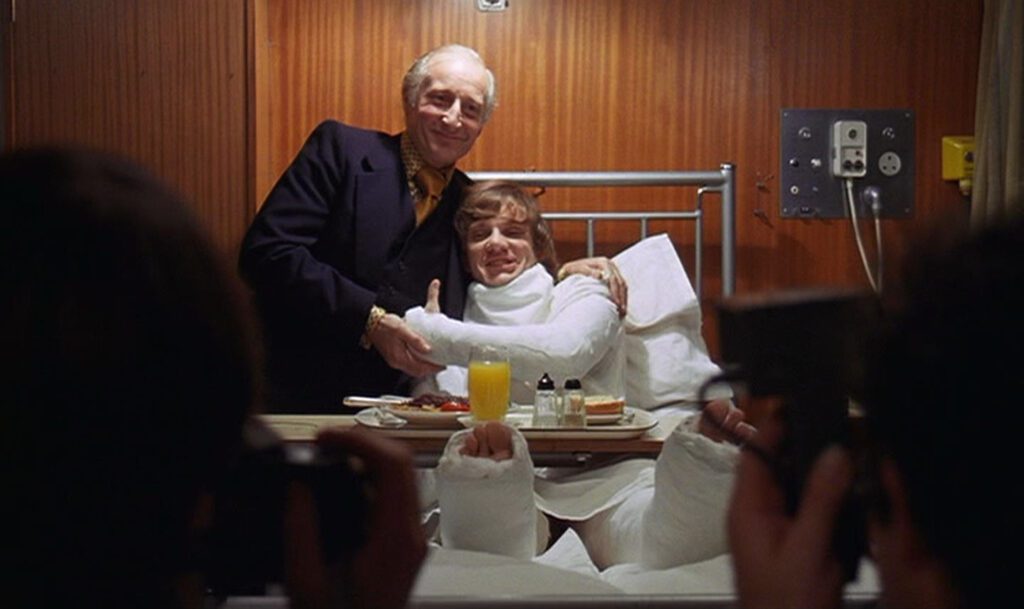
When Alex and the cabinet minister signal their almost filial alliance before a crowd of press photographers at the end, the story has come full circle, and a powerful partnership has coalesced. We’re left to understand that the ruling party will likely carry the next election. But this is not quite the end. There’s one remaining shot of Alex doing “the old in-out in-out” with a young devochka on the ground. In the last line Alex says, “I was cured, all right!” telling us he’s truly his old self again. The shot is probably his fantasy, but it reveals something important – applauding the couple on two sides are rows of finely dressed gentlemen in top hats and ladies with parasols. Alex knows now that he can indulge his instincts, his cruelty as well as sex, in full sight of civilized society without any repercussions.
CONNECTIONS:
The Cabinet of Dr. Caligari – Narrated through a distorted point of view; ends with a patient’s cure
Monsieur Verdoux – Social system that suppresses goodness
Vertigo – Warning against the dangers of oedipal sexuality
Lord of the Flies – Implied comparison between childhood violence and a violent adult world
Dry Season – Link between social violence and oedipal immaturity